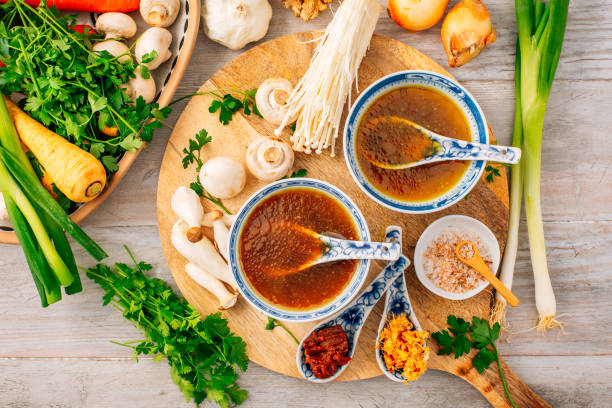Umami foundations: ingredients that strengthen savory bases
A savory base starts with deliberate ingredient choices and simple techniques that concentrate flavor, texture, and aroma. This article explains practical ways to build stock and sauce foundations, how umami develops, and how tools like reduction, clarification, gelatin, aromatics, and acid shape balanced savory results for both meat and vegetarian preparations.

A strong savory foundation depends on layers: a well-made stock, focused reductions, balanced seasoning, and finishing techniques that enhance mouthfeel and aroma. Whether you are building a braise, a pan sauce after deglazing, or a vegetarian broth, understanding how ingredients like collagen, gelatin, aromatics, herbs, and acid interact will make your bases more satisfying and versatile.
How to build a rich stock?
A proper stock is the backbone of many sauces and soups. Start with bones, vegetables, and aromatics simmered gently so collagen converts to gelatin without clouding the liquid. For vegetarian stocks, use roasted vegetables, kombu, dried mushrooms, and strong aromatics to add depth. Clarification can be used when a clear stock is needed: a raft of egg whites and minced aromatics draws out fine solids while leaving flavor intact. Roasting bones or vegetables before simmering encourages Maillard flavors that deepen the stock and increase perceived umami.
How do reductions deepen sauce flavor?
Reduction concentrates flavor by evaporating water and intensifying soluble compounds. When you reduce a stock or wine-deglazed pan juices, sugars caramelize and acids become more pronounced; both changes highlight savory notes. Use gentle heat to avoid bitterness; skim foams to keep clarity. A controlled reduction also improves body, helping sauces coat proteins and vegetables. Balance is important: concentrate until flavors are bold but not overpowering, then adjust with salt, acidity, or a fat to round the finish.
How does umami develop and how to boost it?
Umami arises from free amino acids and nucleotides such as glutamate and inosinate. Ingredients like roasted bones, aged cheese, dried mushrooms, soy, miso, and tomatoes are high in these compounds. In stocks, slow extraction releases glutamates; in sauces, deglazing captures browned bits that are umami-rich. For vegetarian options, combine kombu, shiitake, roasted vegetables, and fermented elements to approximate the depth found in meat-based bases. Small additions of fermented condiments or dried seaweed can dramatically increase savory complexity without excess salt.
How do gelatin and collagen affect mouthfeel?
Gelatin, derived from collagen, gives stock body and a silky mouthfeel that coats the palate and carries flavor. Long, low simmering extracts collagen from bones and connective tissue into gelatin; chilling a good stock should produce a gel. This property helps sauces cling to food and provides a satisfying texture in soups and braises. For lean or vegetarian preparations, use reductions or pectic and starch-based thickeners thoughtfully to emulate some of gelatin’s coating effect without masking delicate flavors.
How to use aromatics and herbs effectively?
Aromatics—onion, carrot, celery, garlic, leeks—and herbs add top notes and complexity. Start aromatics early to build a base during roasting or sweating, and add delicate herbs late to preserve freshness. Toasting or roasting aromatics and whole spices brings out volatile oils and Maillard-derived aromatics that enrich both stock and sauce. When deglazing a pan, use a liquid that complements the aromatics (wine, vinegar, or stock) to lift fond and integrate flavors. For vegetarian stocks, concentrate on umami-rich aromatics like roasted garlic and dried mushrooms.
How do salting, acidity, and thickening finish dishes?
Salting and acid balance are the final sculpting tools. Salt amplifies other flavors and should be layered: season bones, vegetables, and the finished base lightly and adjust at the end. Acidity—vinegar, citrus, wine—brightens reductions and cuts through richness, making umami more perceptible. Thickening techniques (reduction, beurre manié, liaison with cream or egg yolk, or starch roux) modify viscosity and mouthfeel; choose a method that suits the dish and respects the base’s flavor. Deglazing with an acidic liquid after roasting captures browned flavors while adding the acidity needed for balance.
A thoughtful approach to these elements—careful stock building, focused reductions, attention to gelatin and collagen, and precise use of aromatics, herbs, salt, and acid—creates savory bases that support a wide range of dishes. Whether you work with meat or vegetarian ingredients, combining slow extraction, roasting, deglazing, and finishing techniques will produce deeper, more harmonious flavors.





